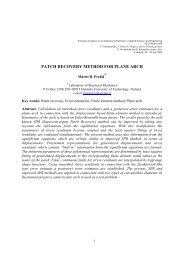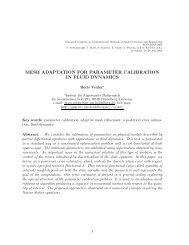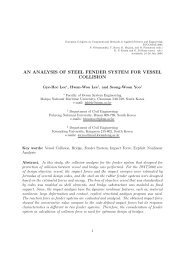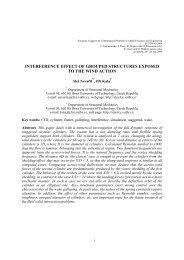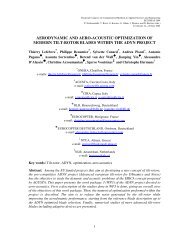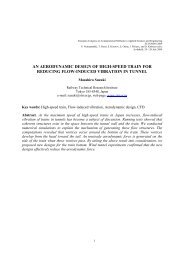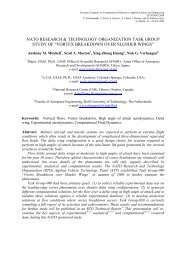Aerodynamic Design of Unmanned and Scaled Supersonic ...
Aerodynamic Design of Unmanned and Scaled Supersonic ...
Aerodynamic Design of Unmanned and Scaled Supersonic ...
Create successful ePaper yourself
Turn your PDF publications into a flip-book with our unique Google optimized e-Paper software.
K. Yoshida <strong>and</strong> Y. Makino<br />
airplane. The main part <strong>of</strong> the improvement was based on how to simulate the operation<br />
condition <strong>of</strong> engine, that is, how to estimate inflow into the intake <strong>and</strong> outflow from the<br />
nozzle as precisely as possible. In general, we <strong>of</strong>ten analyzed the flowfield around the<br />
airplane using the so-called flow–through-nacelle condition as an approximation. To validate<br />
this approximation was one <strong>of</strong> the targets <strong>of</strong> developing advanced design technologies.<br />
1) Concepts related to the aerodynamic design <strong>of</strong> NEXST-1 airplane<br />
In order to improve subsonic aerodynamics, a higher aspect ratio wing was desired after<br />
designing the NEXST-1 airplane. Keeping the same kink position <strong>of</strong> both leading <strong>and</strong> trailing<br />
edges for simplicity, we selected a modified arrow planform with the aspect ratio <strong>of</strong> 2.4 with<br />
0.2 higher than that <strong>of</strong> the NEXST-1 airplane. However, the increment <strong>of</strong> the aspect ratio led<br />
to reducing the swept angle <strong>of</strong> outer wing. Therefore, the outer wing had a supersonic leading<br />
edge <strong>and</strong> every section had a pointed leading edge to reduce the pr<strong>of</strong>ile drag.<br />
A warped wing was designed according to the same design procedure as the NEXST-1<br />
airplane without nacelle condition. The NLF wing design was applied at inner wing only<br />
because the outer wing section had a pointed leading edge. The shpae <strong>of</strong> the target pressue<br />
distribution was the same as that <strong>of</strong> the NEXST-1 airplane, but the pressre level was different.<br />
In general, it is difficult to incorporate any influence <strong>of</strong> shock waves due to the nacelles into<br />
the target pressure distribution. Therefore, the design C L for warp design was specified by<br />
removing the increment due to compression lift generated by two nacelles from the total lift.<br />
JAXA’s CFD calculatons estrimated that the increment <strong>of</strong> compression lift was about 0.06 at<br />
the total lift <strong>of</strong> C L =0.1. Therefore, the NLF wing design was conducted at low lift condition,<br />
that is, C L =0.04 without nacelles. In the design process, geometry modification was also<br />
performed for the simple configuration without nacelles, but CFD analysis for estimating flow<br />
characteristics was conducted for a complete configuration with nacelles.<br />
2) New design concepts<br />
An axisymmetrical area-ruled body for the NEXST-2 airplane was also designed by the<br />
same design procedure as the NEXST-1 airplane under the the following constraints:<br />
minimum diameter, minimum volume <strong>and</strong> maximum length. These constraints made it<br />
difficult to apply the exact area-ruled body concept based on linear theory because <strong>of</strong> the<br />
existence <strong>of</strong> two large engine nacelles. In addition, the design concept besed on linear theory<br />
can not treat the influence <strong>of</strong> shock <strong>and</strong> expansinon waves due to intake <strong>and</strong> nacelle. Therfore,<br />
the area-ruled body concept need to be exp<strong>and</strong>ed to include any nonlinear effects.<br />
The key point <strong>of</strong> the non-axisymmetrical area-ruled body concept is to optimize the upper<br />
<strong>and</strong> lower geometries <strong>of</strong> fuselage independently, using a certain mathematical fomulation <strong>of</strong><br />
two kinds <strong>of</strong> radial distributions as design variables. And total pressure drag was chosen as an<br />
objective function. In addition, the overset grid method is also very useful in optimizing a<br />
complicated wing-body configuration with such large nacelles. The optimum configuration<br />
designed using our CFD-based optimization method was storngly influenced by the initial<br />
configurtion. We designed the initial configuration using present aerodyanimc design<br />
technique <strong>of</strong> the NEXST-1 airplane.<br />
In the develpment phase <strong>of</strong> the method, we designed a non-axisymmetrical optimum area-<br />
13



